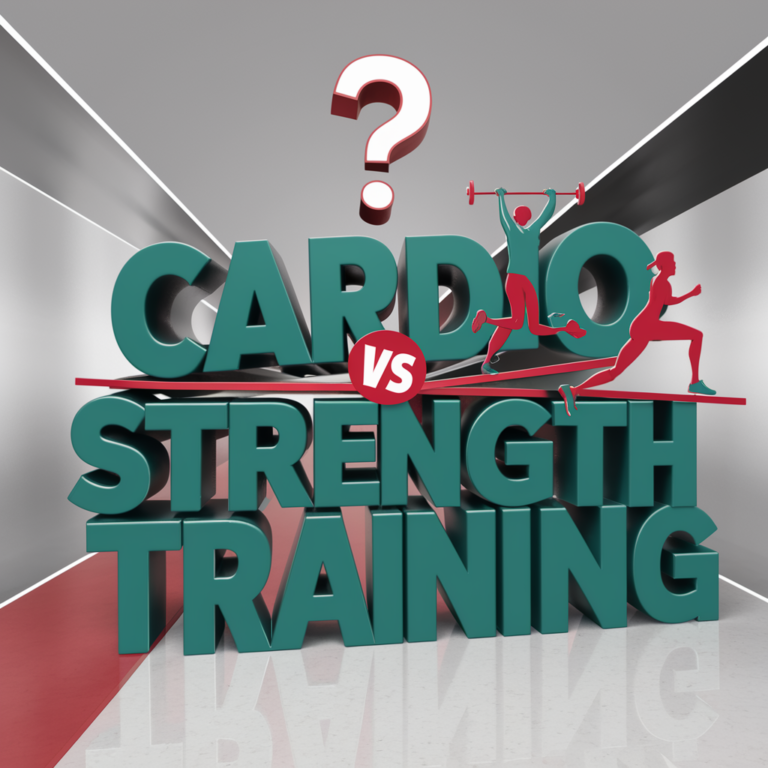Table of Contents
Cardio vs. Strength Training
When it comes to weight loss, the debate between cardio and strength training has been ongoing for years. Both forms of exercise offer unique benefits, and understanding their roles can help you create an effective workout plan tailored to your weight loss goals. In this comprehensive guide, we’ll explore the pros and cons of each, how they affect weight loss, and how to combine them for optimal results.
Understanding Cardio Vs. Strength Training
Cardio (Aerobic Exercise)
Cardio exercises are activities that increase your heart rate and breathing. They improve cardiovascular health, burn calories, and enhance endurance. Examples include:
- Running
- Cycling
- Swimming
- Brisk walking
- Dancing
- High-Intensity Interval Training (HIIT)
Strength Training (Resistance Training)
Strength training involves exercises that use resistance to induce muscular contraction, building strength, anaerobic endurance, and muscle mass. Examples include:
- Weightlifting
- Bodyweight exercises (push-ups, squats, etc.)
- Resistance band workouts
- Pilates
- Yoga (certain styles)
Cardio for Weight Loss
Pros of Cardio
- Burns a high number of calories during the workout
- Improves cardiovascular health
- Can be done anywhere with minimal equipment
- Variety of options to suit different preferences
- Enhances mood and reduces stress
Cons of Cardio
- May lead to muscle loss if done excessively
- Can be hard on joints (especially high-impact activities)
- May not significantly increase resting metabolic rate
- Can become monotonous for some people
- Potential for overtraining and burnout
Cardio and Calorie Burning
Cardio is often touted as the go-to for weight loss due to its high calorie-burning potential. Here’s a comparison of calories burned in 30 minutes for a 155-pound person:
| Activity | Calories Burned (30 min) |
|---|---|
| Running (6 mph) | 372 |
| Cycling (12-14 mph) | 298 |
| Swimming (moderate pace) | 223 |
| Brisk Walking (3.5 mph) | 149 |
Note: Calorie burn varies based on individual factors like weight, intensity, and fitness level.
Strength Training for Weight Loss
Pros of Strength Training
- Builds lean muscle mass
- Increases resting metabolic rate
- Improves bone density
- Enhances overall body composition
- Supports joint health and stability
Cons of Strength Training
- May not burn as many calories during the workout as cardio
- Can be intimidating for beginners
- Requires proper form to avoid injury
- May require equipment or gym membership
- Progress can be slower compared to immediate calorie burn of cardio
The Afterburn Effect
Strength training has a unique advantage known as the “afterburn effect” or Excess Post-exercise Oxygen Consumption (EPOC). This refers to the increased calorie burn that continues after the workout has ended. Studies have shown that strength training can elevate metabolism for up to 72 hours post-workout, contributing to long-term weight loss and management.
Combining Cardio and Strength Training
While both cardio and strength training have their merits, the most effective approach for weight loss often involves combining the two. This strategy, known as concurrent training, offers the best of both worlds:
- Maximizes calorie burn during and after workouts
- Improves overall fitness and health
- Prevents boredom and workout plateaus
- Supports long-term weight management
- Enhances body composition by burning fat and building muscle
Sample Weekly Workout Plan
| Day | Workout |
|---|---|
| Monday | Strength Training (Full Body) + 20 min HIIT |
| Tuesday | Moderate-Intensity Cardio (45 min) |
| Wednesday | Strength Training (Upper Body) + 15 min Cardio Cooldown |
| Thursday | Rest or Light Activity (e.g., Yoga, Walking) |
| Friday | Strength Training (Lower Body) + 15 min HIIT |
| Saturday | Longer Cardio Session (60+ min, moderate intensity) |
| Sunday | Rest or Active Recovery |
Tips for Effective Weight Loss
- Focus on Progressive Overload: Gradually increase the intensity, duration, or resistance of your workouts to continue challenging your body.
- Prioritize Nutrition: Remember, weight loss is 80% diet and 20% exercise. Ensure you’re in a calorie deficit through a balanced, nutritious diet.
- Stay Consistent: Regular exercise is key. Aim for at least 150 minutes of moderate-intensity or 75 minutes of vigorous-intensity exercise per week.
- Listen to Your Body: Allow for adequate rest and recovery to prevent burnout and injury.
- Track Your Progress: Use measurements, photos, and how your clothes fit rather than relying solely on the scale.
- Stay Hydrated: Proper hydration supports metabolism and exercise performance.
- Get Enough Sleep: Adequate sleep (7-9 hours per night) is crucial for weight loss and recovery.
Frequently Asked Questions
Q: Will lifting weights make me bulky?
A: This is a common misconception, especially among women. Building significant muscle mass requires a specific diet, training regimen, and often genetic predisposition. For most people, strength training will lead to a lean, toned appearance rather than bulk.
Q: How long should my workouts be for effective weight loss?
A: The duration depends on the intensity and type of exercise. Generally, aim for 30-60 minutes per session. High-Intensity Interval Training (HIIT) can be effective in as little as 20 minutes, while moderate-intensity cardio might require 45-60 minutes for optimal benefits.
Q: Is it better to do cardio before or after strength training?
A: If your primary goal is weight loss, doing cardio after strength training may be more beneficial. This allows you to perform strength exercises with more energy, potentially lifting heavier weights and building more muscle. The cardio session afterward can then tap into fat stores more effectively.
Q: How often should I change my workout routine?
A: It’s good to vary your routine every 4-6 weeks to prevent plateaus and keep your workouts engaging. This doesn’t mean a complete overhaul; small changes like altering rep ranges, trying new exercises, or adjusting workout order can be effective.
Q: Can I lose weight with just diet, without exercise?
A: While it’s possible to lose weight through diet alone, combining diet with exercise offers numerous benefits beyond just weight loss. Exercise helps maintain muscle mass during weight loss, improves cardiovascular health, boosts mood, and supports long-term weight management.
Conclusion
When it comes to weight loss, both cardio and strength training play crucial roles. Cardio excels at burning calories during the workout and improving cardiovascular health, while strength training builds muscle, boosts metabolism, and enhances overall body composition.
The most effective approach for most people is to combine both types of exercise, creating a well-rounded fitness routine that maximizes fat loss while preserving and building lean muscle mass. Remember, the best workout plan is one that you enjoy and can stick to consistently.
Ultimately, sustainable weight loss requires a holistic approach that includes regular exercise, a balanced diet, adequate sleep, and stress management. By incorporating both cardio and strength training into your routine, you’re setting yourself up for long-term success in your weight loss journey and overall health.
Key Takeaways
- Both cardio and strength training contribute to weight loss in different ways
- Cardio burns more calories during the workout
- Strength training increases muscle mass and boosts metabolism long-term
- Combining both types of exercise often yields the best results
- Consistency and a balanced diet are crucial for sustainable weight loss
- Listen to your body and adjust your routine as needed

